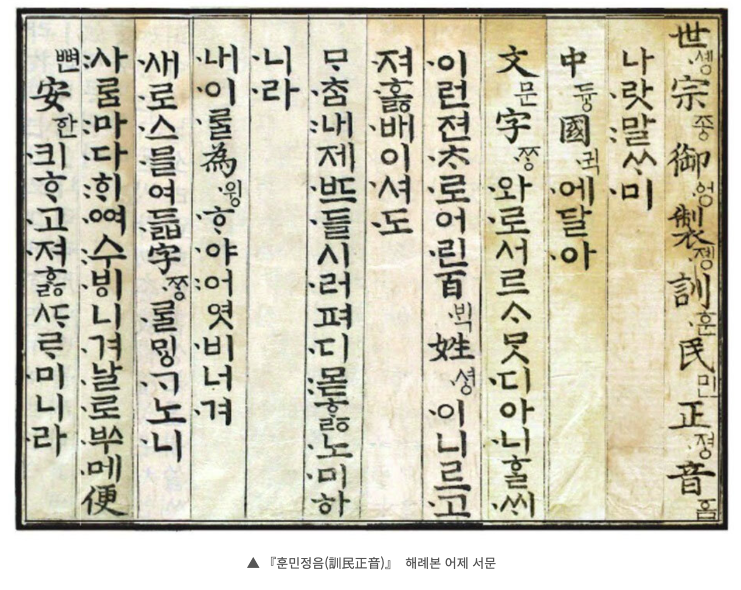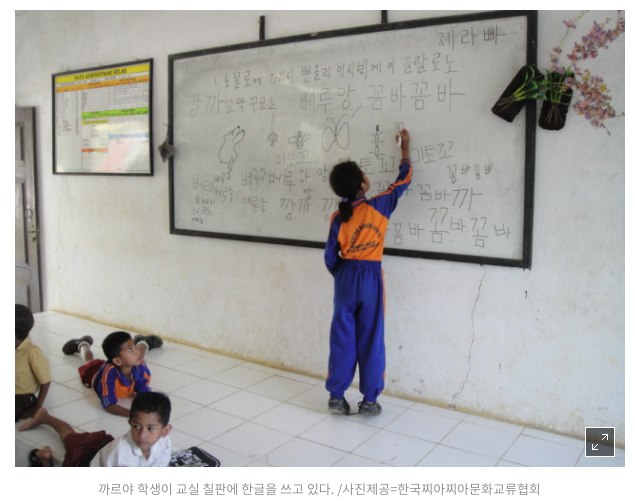Hangeul as an Art Living in a foreign country as a Korean, I learned a foreign language first, made friends with local persons, and adapted to that their culture, customs, rules, climate, and food. It is the usual adaptation process that immigrants must follow as a routine for survival. But there is such a thing. It is said that anyone who leaves the country automatically becomes a real patriot. Only those who have left their homeland can feel it is a special feeling with nostalgia. In other words, the story means that things that you took for granted, like air, no longer take for granted, and you come to realize the importance and meaning of your hometown and country that you didn't know before. As I recognize the experience one by one, I am building my identity as immigrants and Koreans. In particular, when living as a Korean in a foreign country and interacting with the people in those countries, I get many questions about Korea. The first question is about Korean, Hanguel. It is said that there are about 7,000 languages in our world. Korean is one of them, and it is a language-specific to Korea (75 million speaker), not a language most spoken by many like English, Mandarin, Hindi and Spanish,etc. Therefore then did I have to explain Korean in my own way. Above all, I get excited when I meet people interested in our language. It contains a lot of curiosity, mysterious spirit, and pioneering spirit as if revealing an unknown world. Especially, Hangul looks like a code or password for foreigners to see. It's because it's not a typical alphabetic system, and it's not a Mandarin-like Chinese character. It's completely different. The consonants of Hangeul are modeled after the shape of the human pronunciation organ, and the vowels are modeled after the basic things of the world, such as the sky, earth, and people. Korean is Like English, it is a phonetic character that expresses sounds with letters. Still, in English, notes are made by listing vowels and consonants, whereas in Korean, vowels, and consonants are assembled like Lego blocks to make letters. Also, sounds come together to express meaning, and each letter does not have a meaning, so there is no need to memorize the purpose, meaning, and pronunciation of every letter like Mandarine. Since the letters are made according to how they pronounce, you can make a sound according to the shape of the letter backward, and you can write the letters as you make the sound. Because of these characteristics, the practicality of Hangul is amplified when it is combined with a computer system or mobile keyboard. The Hangul keyboard consists of 19 consonants and 21 vowels, so anyone who knows Hangul can quickly enter Hangul using the keyboard without any special training or additional supporting system. Hangeul, which is currently conveniently used by Koreans, has the characteristic that it is clearly known who made it, when it was made, and on what principle it was made. The origin of Hangeul was created by King Sejong the Great, the king of the Joseon Dynasty in 1446. King, Sejong felt heartbroken that ordinary people were not correctly finding their rights as human beings while living without letters. They tried to appeal to the government office, but there was no way to appeal. Even after an unfair trial, there was no way to demand that they be corrected, and even if they tried to write a letter, they could not do it because they didn't learn the complex Chinese characters. Above all, there was no way to keep a simple record of agricultural work. Their work were transferred to junior farmer only with verbal order. Without any record, they couldn't get any knowledge for using and upgrade their skills and life styles. Sejong was a heart warm king who felt very sorry for the plight of the people and had an innovative character with solid subjectivity. Sejong realized that Chinese is written by special heirarcial people, even if I borrowed Chinese characters to write Korean, it was very awkward, and I could not convey the meaning correctly. On the other hand, it seems that the situation was equipped with various conditions to create new characters. King Sejong created 28 Hunminjeongeum in 1443 and published a book called Hunminjeongeum in September 1446 by the lunar calendar with detailed explanations (interpretations) and usage examples (examples). There are several names for Hangeul. When King Sejong invented Hangeul, it was called 'Hunminjeongeum', which means 'the right sound to teach the people. [Source: Encyclopedia of Korean National Culture (Korean)] According to the Hunminjeongeum Haeryebon, Hangeul was created according to the yin-yang principle and five elements. According to the Yin-Yang Five Elements theory(陰陽五行論), all the separate phenomena of the universe or humans appear in pairs of yin and yang (bottom-up, low-high, female-male). The Five Elements theory states that all things in the universe are created and destroyed by performing the five elements of gold (金), water (水), wood (木), fire (火), and earth (土) according to the principle of yin and yang(五土). They got hints from nature and the principles of the universe and life and encoded them according to the high and low flow of energy. That's why, Korean is like Cubics, if you assemble each one, one letter is completed. Instead of arranging consonants and vowels one after the other, they are three-dimensionally inserted up, down, left, and right to create one letter. In addition, the vast amount of data such as the flow of energy, nature, and the order and principle of the universe is visually simplified as shown below. In a word, it is the perfect application of minimalism to linguistics. While using Hangeul, I was surprised that 500 years ago, humankind had the wisdom to create characters by simplifying data into a scientific framework. Characters and languages are created through the accumulation of time and experience with many trial and errors. So it's unclear where the letters came from, who made them, and when. To make a language need many times and experiences. Many people use it a lot, and it is refined over a long time. However, in the case of Hangeul, it was made in a short period out of necessity. However, there is no difficulty in writing so far, and since it is a character that writes the sound as it is, it is effective as a language to learn and use for instance when some tribe has only the sound without any letters, and it can be transmitted to a tribe that does not have their own letter practically. It is the case with Ciaccia, an indigenous language spoken by about 70,000 Ciaccia people living in Baubau, Buton Island, Indonesia. It was in danger of disappearing soon, as there was no unique script to write the language, and history and culture could not be recorded. 'Hangeul teacher' Jeong Deok-young was first dispatched to the Chiachia village and taught Korean directly there. Hangeul is useful for tribes with non-literate languages, as all sounds can be written down. Above all, when I look at Hangeul from an artistic point of view, I am amazed at its simplicity and beauty. The shape of nature has been simplified with points, lines, and planes like the elements of art. The point, Line, and Plane are the most fundamental design elements. Hanguel designed by simplified basic element to indicate the human organ for pronunciation. In a nutshell, human is representative as human pronouncial organs as consonant and the energy of nature as vowels have been combined in a letter. The human and nature combines the two results in one character. A long time ago, people already knew the energy in nature and the universe, and they created letters by responding to human organs. This is different from other languages that have been simplified by imitating the shape of objects, and put it the meaning and pronunciation. In other words, it is the principle of bringing the philosophical theory to create a languages and tried to express the universal true that eventually becoming one with nature and humans. I plan to write another separate post with a separate topic on the process of creating Hangeul based on these oriental philosophical thoughts.
0 Comments
Leave a Reply. |
Myungja Anna KohArtist Categories
All
Archives
July 2024
|
Proudly powered by Weebly











 RSS Feed
RSS Feed